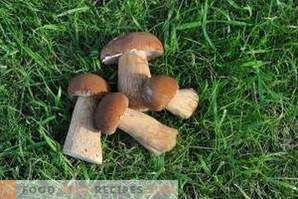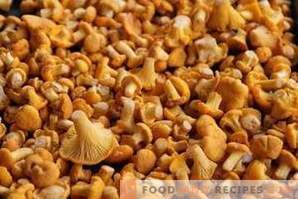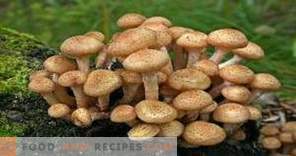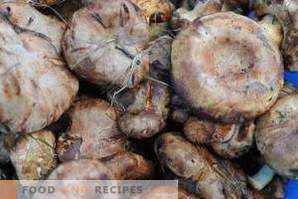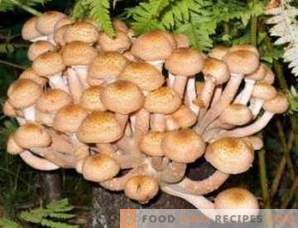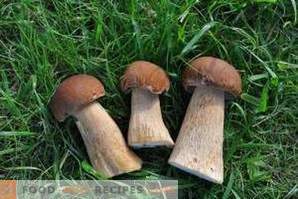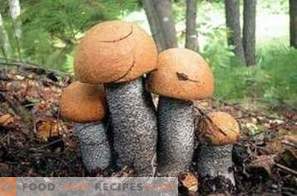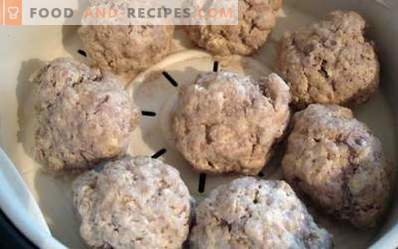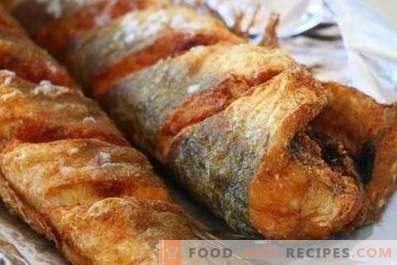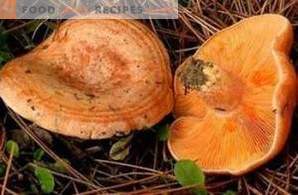
Ryzhiki is not such a popular mushroom as, say, a white mushroom, but due to some of its qualities it is much better than it.
- Ryziki contains 3, 08% of proteins, 2, 18% of carbohydrates, 0, 71% of fats.
- In these mushrooms there is phosphorus, magnesium, sulfur, chlorine, calcium, sodium.
- There is glucose, trehalose or mycosis, glycogen (animal starch).
- Ryzhiki is rich in vitamin A, so their frequent consumption improves eyesight.
- In these mushrooms there is a natural antibiotic lactaric acid and is used to treat tuberculosis.
- Eating mushrooms in food improves metabolism.
- Despite the presence of milky juice in ryzhiki, they can be eaten raw, and they do not require soaking or pre-boiling during cooking. Milky redfish juice is not bitter. Only spruce mushrooms slightly bitter.
Where are the mushrooms growing
There are two main types of mushrooms - spruce and pine.
Unlike the white fungus, which grows only in adult forests, the small red mushroom likes to settle in young: near young pines, young spruce forests, mixed forests, dense grass, but not high, among mosses.
If Spruce Fir grows most often in the forest, even mixed, then Pine Fishes can grow even near a single tree, for example, in a public garden or a park in the city.
Ryzhiki grow on glades slightly dimly lit by the sun, in places where there are pines, firs, spruces, and cedars. This mushroom is found in the Urals, in Siberia, in the Far East, in Kazakhstan, in the Crimea, in central Russia, in Moldova.
Ryzhik loves sandy soils, so it does not settle on waterlogged soil.
Ryzhiki is difficult to confuse with any other mushrooms, as they have a remarkable appearance - a bright orange cap, which is convex in a young mushroom, and becomes funnel-shaped in an adult. On the camelina's hat darker circles are well visible. True, the fir fir is darker and with circles of a greenish hue. The underside of the mushrooms (plate) orange. Leg short, hollow inside. On a break, it produces a milky sap of the same color as the cap.
The peculiarity of Ryzhikov is that even in a group they may have hats of different shades. For example, if a family of red mushrooms settled under a spruce, then those mushrooms that turned out to be in the shade have a bright orange color, while others that have more sun left look as if burned out, faded.
Ryzhiki love to hide in the grass, so it's hard to find them right away. It is necessary to carefully look at their feet, wand spreading the foliage, pine needles, tangled plant stems. If you manage to see one mushroom, it means that a whole family of red mushrooms is hiding around it. After all, mushrooms one by one practically do not grow.
It is noticed that if the weather is rainy, then there are more fir mushrooms, and when dry weather increases, the yield of pine mushrooms increases.
When to collect mushrooms
The first mushrooms appear already in July, but it is time for the abundance of these mushrooms to in August and lasts from until September.
The first are fir (summer) mushrooms, which can be collected at the end of July. Then comes the turn for pine mushrooms (autumn), which grow up to frost.
However, depending on the climatic conditions, the time of appearance of fungi can vary, and in a warm climate mushrooms can grow from May to November.
There are natural signs, which can determine the appearance of mushrooms:
- If the berries have ripened raspberries, blueberries, strawberries, and also appeared white mushrooms of the second layer, then after three weeks you can go for mushrooms.
- Where the oil boars were spotted in June and July - in September and October there will be mushrooms.
- Heather bloomed - it's time for mushrooms.
What novice mushroom pickers should know
Red mushrooms are collected in the morning, until dew has dried on the grass. Then the mushroom caps glisten in the sun from moisture and are clearly visible.
The sun should shine in the back, so as not to blind the eyes and not interfere with the "quiet hunt."
If some mushrooms are not taken by any worm, for example, milk mushrooms or volnushki, then for larvae and worms ginger is a tasty morsel. It happens that in the morning small mushrooms still have one wormhole, and by evening they are all riddled with insects. Therefore, mushrooms are collected when they are very small. And they always look at the leg: if the leg is without wormholes, then the whole mushroom. Some mushroom pickers are frightened by the greenish look of cut mushrooms. But this is their peculiarity, since they are very gentle and turn green at the slightest touch of their plate.
Favorable temperature for the growth of mushrooms 10-12 ° heat. At the very first frost mushrooms, as if on cue, disappear.
Ryzhikov has years with abundant growth and rest periods. Most often, a rich harvest happens once every three years.
Ryzhiki spoil quickly (darken, they get worms), so they need to be processed as soon as possible after harvest. Therefore, some mushroom pickers salted mushrooms right in the forest. To do this, they harvests barrels or plastic (not metal!) Containers. Mushrooms are cleaned of debris, pine needles, cut off the tips of the legs, wipe the mushrooms with a towel, put in a container and pour in layers of coarse salt.
The camelina has a fellow - false camelina. It differs from the present in bright red milky juice, which after some time turns green. This mushroom has white flesh on its break. False saffron is quite an edible mushroom and is also salted.


